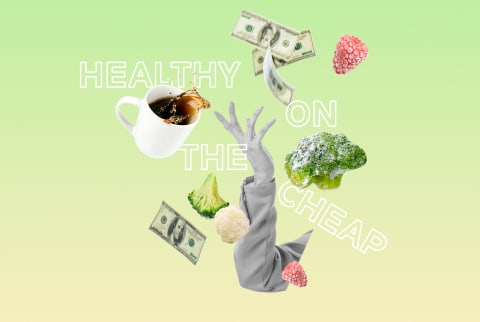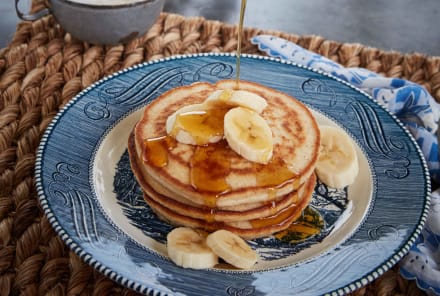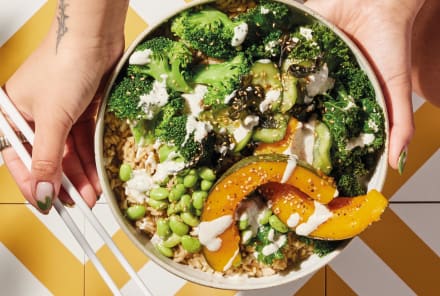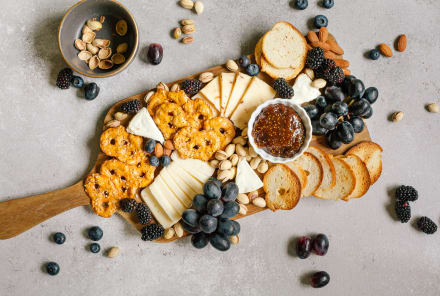Advertisement
Eating Healthy Is So Effing Expensive. How Can I Make It Actually Affordable?


"I want to eat healthy, but between the smoothie powders and the grass-fed meats and the pastured eggs and the organic everything, it gets really expensive! How can I eat well without going broke?" — Chloe, 32
If I had a nickel for every time someone messaged me about healthy food being expensive, I'd be rich enough to, well, live the lifestyle they think I'm promoting. But here's the thing—there is a way to have eating well cost a ton of money, and it's often what you see touted on Instagram. You can dump six different types of adaptogens into your ceremonial-grade matcha blended with premium coconut butter for breakfast and make almond-flour-based baked goods smeared with pricey nut butters as a snack. This stuff is popular, because—let's face it—it photographs well and is interesting enough for influencers to rack up the likes. But it's also not what comprises the core of wellness.
Let's start with the core of a healthy diet, which most doctors agree should be made of vegetables. Vegetables, luckily, are one of the cheaper healthy foods around, especially if you consult the EWG's Clean Fifteen and focus your organic efforts on only the most sprayed crops. I also always recommend joining a CSA (I do Local Roots here in NYC; you can use this site to find a CSA near you). Not only is it cheaper than many organic markets, but you're actually paying far less per nutrient since food you buy in the grocery store is often shipped long distances and can lose more than 50 percent of its vitamin content en route (spinach loses 100 percent of its vitamin C after just four days). Think of it this way—you can eat two apples from a grocery store that was shipped from Washington and cold-stored for up to a year, or you can eat one apple from your CSA, which will have been picked within a few days and will have more nutrients than the other two combined. Even if it happens to be more expensive up front, the real savings in terms of nutrients are significantly higher.
I also always recommend not skimping on your freezer section, which is one of the biggest bargains in the grocery store. Freezer vegetables are often cheaper than their fresh counterparts, and because they're flash-frozen shortly after being picked, they retain far more nutrients. I have a freezer broccoli and basil soup in my new cookbook that I created after a farmer told me he never buys grocery store broccoli—to him, it's like eating nutrient-free fiber (which, compared to fast food, is great—but why settle when you could have even better?). While other cookbook authors haven't really caught on to the freezer game, you can still sub freezer vegetables into most recipes. Just give them a bit more time to cook since you need to let the water evaporate before any browning can occur, and be wary about using them in recipes looking for crispness or crunch (a soup is likely fine; buffalo cauliflower might not be).
While everyone's dietary needs and restrictions differ, I always recommend viewing meat as a condiment, a philosophy renowned functional doctor Mark Hyman, M.D., endorses. I fill the bulk of my plate with vegetables, then use well-raised meat, pastured eggs, or sprouted grains to fill the remaining 15 to 20 percent. This helps cut back on costs by quite a bit, and, while we still haven't cracked what the healthiest diet in the land is, most doctors would agree that if vegetables comprise the bulk of it, you're doing pretty well. I order my meat online from ButcherBox, and I also try to look for cuts that tend to be cheaper—stew meat that I can tenderize in my Instant Pot, for instance, instead of pricier steaks.
Speaking of ordering online, I also love to get nuts and seeds, some of the priciest parts of healthy eating, in bulk and store them in my freezer so the fragile oils don't go rancid. Nuts.com is far, far cheaper than any of my local grocery stores, and they carry organic versions of even more "out-there" nuts like macadamia, so I can get a wide variety of flavors and nutrients in my diet.
Americans waste up to 40 percent of their food, which, put another way, means that you could almost cut your food budget in half simply by eating everything you purchase.
Speaking of freezers (can you tell I love my freezer?), they’re your best friends when it comes to mitigating food waste, which costs Americans $165 billion per year. Americans waste up to 40 percent of their food, which, put another way, means that you could almost cut your food budget in half simply by eating everything you purchase. Greens about to go bad? Give 'em a wash then toss them in the freezer to use for smoothies later. Got a little bit of stock or broth leftover from a recipe? Freeze it in an ice cube tray, then pop out the cubes and use them to deglaze vegetables or add umami tones to stir-fries later. Vegetable scraps can be stored in a freezer bag and boiled with water to make your own veggie broth later (which you can then, yes, store in the freezer). Avocados can be cubed and frozen to use in smoothies. Chicken can be torn into pieces and stored in a Stasher bag to be warmed in a pan and tossed into salads or grain bowls later.
I could go on forever, but in the interest of time, let's quick-fire for a second. You don't need nut milks in smoothies—use filtered water and toss in some hemp seeds for creaminess, which is, in essence, like making your own hemp milk directly in the mix (save your nut milk for where you can really taste it and enjoy it!). Buying pre-prepared vegetables is usually at least double the price—put on a podcast and chop 'em yourself (have leftovers? Stick 'em in the—you guessed it—freezer!). Buy online as much as possible—prices are much lower than comparable retail stores, especially in major cities with high rent (in addition to ButcherBox and Nuts.com, I love Thrive Market, a membership site that sells healthy food for 25 to 50 percent off, and Amazon, which has widely expanded its options since partnering with Whole Foods). Treat expensive, paleo baked goods as a special treat, not a daily indulgence—your wallet and body will thank you. Make your own fancy coffee drinks and matchas instead of buying them out—but also remember that plain old tea and coffee taste great and have tons of health benefits. Superfood powders are fun but should typically be used when recommended for specific conditions by a natural health care provider. Plus, as I always say, spices are the original superfoods, and they bring a ton of flavor to the party with their mega health benefits (I like Simply Organic).
The bottom line? Don't buy something because it's trendy or because you see it in a pretty picture. Eat what feels good to your body, try not to waste anything, and watch your wallet and happiness grow.
Have more healthy eating questions? Hit me up at liz@mindbodygreen.com, and you might see them answered in future pieces on the site!
Watch Next
Enjoy some of our favorite clips from classes
Enjoy some of our favorite clips from classes
What Is Meditation?
Mindfulness/Spirituality | Light Watkins
Box Breathing
Mindfulness/Spirituality | Gwen Dittmar
What Breathwork Can Address
Mindfulness/Spirituality | Gwen Dittmar
The 8 Limbs of Yoga - What is Asana?
Yoga | Caley Alyssa
Two Standing Postures to Open Up Tight Hips
Yoga | Caley Alyssa
How Plants Can Optimize Athletic Performance
Nutrition | Rich Roll
What to Eat Before a Workout
Nutrition | Rich Roll
How Ayurveda Helps Us Navigate Modern Life
Nutrition | Sahara Rose
Messages About Love & Relationships
Love & Relationships | Esther Perel
Love Languages
Love & Relationships | Esther Perel











